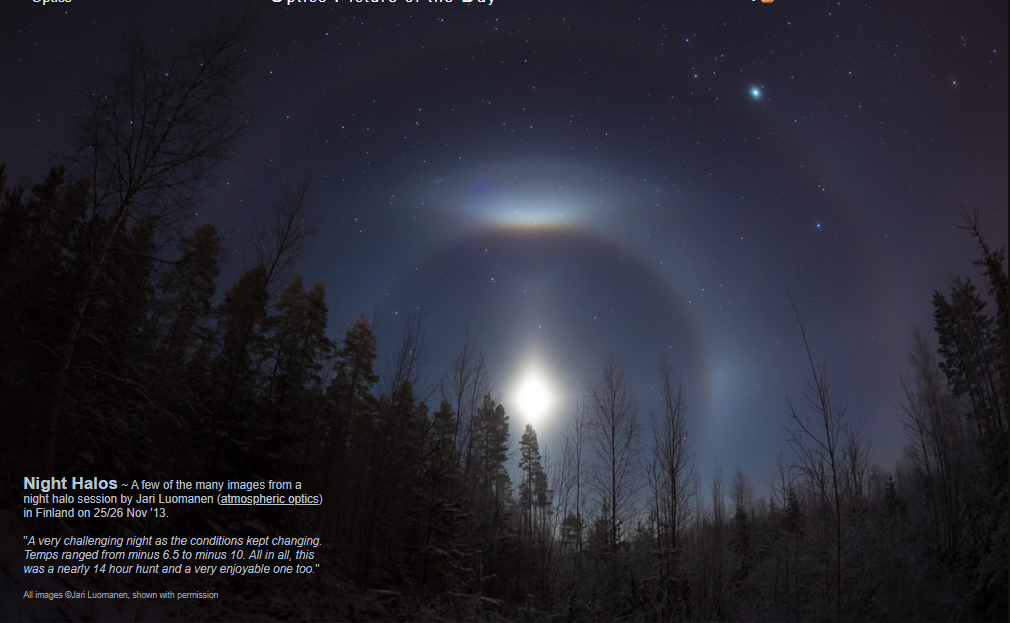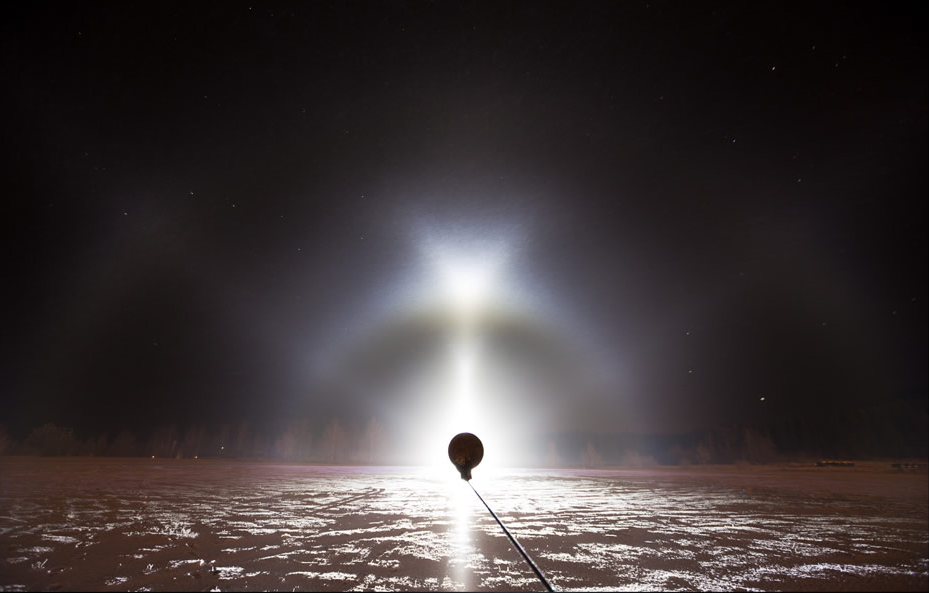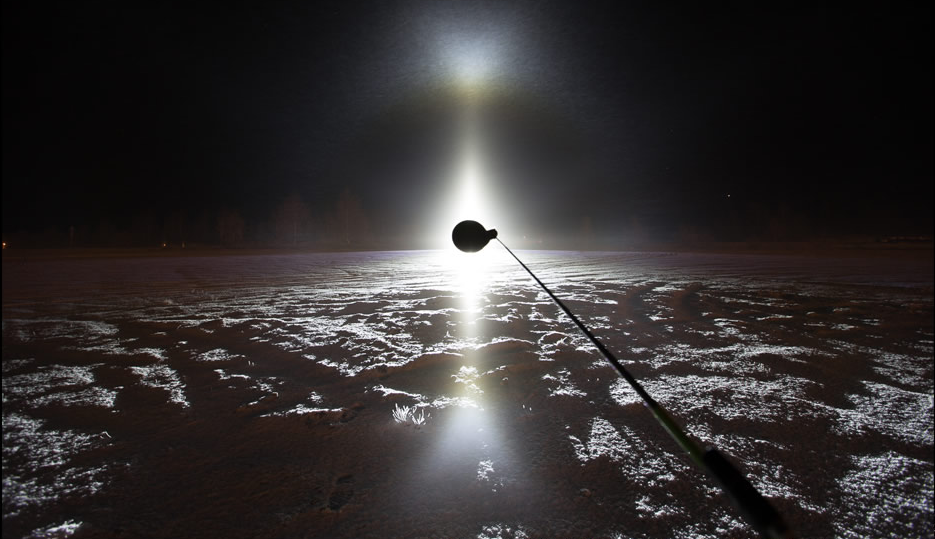Night Halos, Finland - OPOD
Night Halos, Finland: An Enchanting Display of Atmospheric Optics
Night halos are a captivating phenomenon that illuminates the dark skies of Finland. These celestial displays, captured by Jari Luomanen, a passionate atmospheric optics enthusiast, showcase the mesmerizing beauty of these rare optical phenomena. During a grueling 14-hour expedition in November 2013, Luomanen braved changing temperatures ranging from minus 6.5 to minus 10 degrees Celsius to capture these stunning images.
The images captured by Luomanen offer a glimpse into the intricate details of night halos. One notable feature is the distinct lunar upper Parry arc, which appears above the diffuse upper tangent arc and the more commonly observed 22° halo. However, what makes these images truly remarkable is the enigmatic Moilanen arc, situated within the 22-degree halo and above the moon. Despite extensive research, the crystal origin of the Moilanen arc remains a mystery, adding an air of intrigue to these already captivating displays.
When examining the stacked images captured by Luomanen, it becomes evident that there are not many plate crystals present, as indicated by the weak paraselenae and the absence of a circumzenithal arc. This scarcity of plate crystals contributes to the uniqueness and rarity of the night halos observed in Finland.
Finland's halo observers equip themselves with their own lamps to enhance their visibility during nighttime expeditions. This practice allows them to capture artificial light-generated halos, such as helic (heliac) arcs. One particular example of these artificial light-generated halos is seen in Luomanen's images taken near the Himos ski center in Jämsä, Finland. These diamond dust halos, formed downwind of snow guns, create a dazzling spectacle against the dark sky.
The images also reveal the presence of both upper and lower tangent or Parry arcs, further enriching the variety of halos observed in Finland. Stacking multiple images offers the advantage of removing misleading cloud streaks, revealing finer details, and even uncovering additional halos that may have been initially hidden from view.
One such discovery made through stacking is the prominent V-shaped Moilanen arc, which stands out in the images. Below it, a new arc, first imaged by Marko Mikkilä and later captured by Luomanen, adds to the ever-expanding collection of observed halos. Nicolas Lefaudeux has proposed that crystals with a 34-degree interfacial angle could be responsible for the formation of these arcs. When the prism points upwards, a Moilanen arc is produced, while tumbling about the horizontal prism axis can generate a diffuse arc below it. However, the nature of these crystals containing the elusive 34-degree wedge remains an unsolved puzzle.
In conclusion, the night halos observed in Finland offer a captivating display of atmospheric optics. Jari Luomanen's dedicated efforts to capture these rare phenomena have provided invaluable insights into the intricate details of these optical displays. From the mysterious Moilanen arc to the artificial light-generated helic arcs, Finland's night skies truly come alive with enchanting halos. The continued exploration and research into these phenomena will undoubtedly unravel more of their secrets and deepen our appreciation for the wonders of the natural world.

Night Halos ~ A few of the many images from a night halo session by Jari Luomanen (atmospheric optics) in Finland on 25/26 Nov '13.
"A very challenging night as the conditions kept changing. Temps ranged from minus 6.5 to minus 10. All in all, this was a nearly 14 hour hunt and a very enjoyable one too."
All images ©Jari Luomanen, shown with permission

Notable is the distinct lunar upper Parry arc above the rather diffuse upper tangent arc and 22° halo.
Inside the 22 degree halo and above the moon is the enigmatic Moilanen arc whose crystal origin is as yet not explained.
Stacked images - see below - show Jari's second sighting of a new halo below the Moilanen arc.
There are not many plate crystals as evidenced by the weak paraselenae and no circumzenithal arc.
Halo keys - common, not so common.

Finland halo observers carry their own lamps.
Some artificial light generated halos including helic (heliac) arcs.
These are all diamond dust halos downwind of snow guns at the Himos ski center, Jämsä, Finland.

Upper and lower tangent or Parry arcs - or both!

Stacked images. Stacking can remove misleading cloud streaks, reveal more detail and show extra halos.
Here the V-shaped Moilanen arc shows up strongly. Below it is possibly the new arc imaged for the first time by Marko Mikkilä (who also first imaged the Kern arc).
Jari Luomanen imaged it in 2006 and his stacked image at right is the third sighting.
Nicolas Lefaudeux has suggested that crystals containing a 34 degree interfacial angle could be responsible. When the prism points upwards a Moilanen arc results. Tumbling about the horizontal prism axis can produce a diffuse arc below the Moilanen arc. However, the nature of the crystals containg the required 34 degree wedge remains a mystery.

Note: this article has been automatically converted from the old site and may not appear as intended. You can find the original article here.
Reference Atmospheric Optics
If you use any of the definitions, information, or data presented on Atmospheric Optics, please copy the link or reference below to properly credit us as the reference source. Thank you!
-
<a href="https://atoptics.co.uk/blog/night-halos-finland-opod/">Night Halos, Finland - OPOD</a>
-
"Night Halos, Finland - OPOD". Atmospheric Optics. Accessed on November 24, 2024. https://atoptics.co.uk/blog/night-halos-finland-opod/.
-
"Night Halos, Finland - OPOD". Atmospheric Optics, https://atoptics.co.uk/blog/night-halos-finland-opod/. Accessed 24 November, 2024
-
Night Halos, Finland - OPOD. Atmospheric Optics. Retrieved from https://atoptics.co.uk/blog/night-halos-finland-opod/.